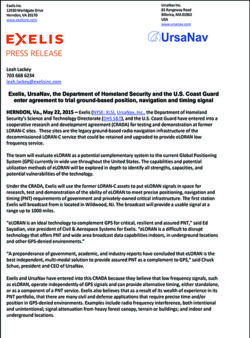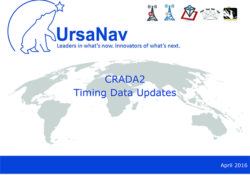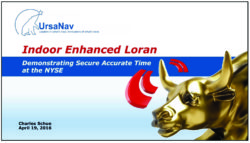In February 2012, UrsaNav entered into a Cooperative Research And Development Agreement (CRADA) with the US Department of Homeland Security (DHS) and the US Coast Guard (USCG) to research, evaluate, and document at least one alternative to the Global Positioning System (GPS) as a means of providing precise time, specifically a wireless technical approach for providing precise time for use by a variety of networks including maritime and navigation systems. This CRADA remained in effect until March 2014 with considerable positive results, including verifying and validating previous USCG and FAA findings.
In May 2015, UrsaNav brought Exelis, Inc. into a follow-on CRADA with the DHS and USCG. Under this planned three-year effort, CRADA partners were to research, evaluate, and document eLoran technology as a candidate for providing positioning, navigation, and timing (PNT) information. eLoran was to be evaluated as a potential complementary system to the current Global Positioning System (GPS) currently in wide use throughout the world. The capabilities and potential utilization methods of eLoran were to be explored in depth, to identify all strengths, capacities, and potential vulnerabilities of the technology. After its acquistion of Exelis in 2015, Harris Corporation assumed the role of partner with UrsaNav in the CRADA. UrsaNav spent considerable time training Harris Corporation personnel on all aspects of Loran-C and eLoran as they did not have this expertise or experience previously. This CRADA expired in May 2017.
UrsaNav believes that there is a potentially viable market, in both the public and private domain, for an alternative PNT service that is independent of GPS signal reception or which can be used in GPS-denied environments. The overall goal of the CRADAs was to demonstrate eLoran’ s ability to meet PNT needs in regards to providing redundancy and resiliency to critical infrastructure, by testing positioning accuracy, messaging, and timing signal capabilities using either legacy Loran-C facilities updated to eLoran standards, or new eLoran facilities in the United States. The agreement also encouraged exercises of eLoran timing, emergency messaging services, and position capabilities in regional emergency response scenarios using CRADA resources.
Below find our latest CRADA materials sharing insider details to current initiatives and outreach.



